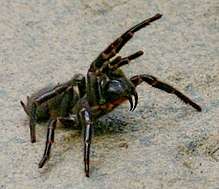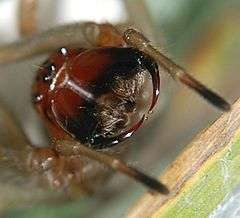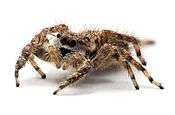Araneomorphae
The Araneomorphae (also called the Labidognatha) are an infraorder of spiders. They are distinguished by having chelicerae (fangs) that point diagonally forward and cross in a pinching action, in contrast to the Mygalomorphae (tarantulas and their close kin), where they point straight down. Most of the spiders that people encounter in daily life belong to the Araneomorphae.
| Araneomorph spiders | |
|---|---|
| Nephila inaurata (Nephilidae) | |
| Scientific classification | |
| Kingdom: | Animalia |
| Phylum: | Arthropoda |
| Subphylum: | Chelicerata |
| Class: | Arachnida |
| Order: | Araneae |
| Suborder: | Opisthothelae |
| Infraorder: | Araneomorphae |
| Families | |
|
see Table of families | |
| Diversity | |
| 95 families | |
_W2_IMG_2780.jpg)
Distinguishing characteristics
Note the difference in the orientations of the chelicerae (fangs) of the two spiders below, representatives of the Mygalomorphae and the Araneomorphae. The number of book-lungs (when present) can also help distinguish between members of these two major groups.
Mygalomorphae
This Atrax robustus (a member of the Hexathelidae) is presenting a defensive posture, and by so doing clearly shows the orientation of its chelicerae, which go up and down and parallel to the long axis of the spider's body, as with other representatives of the Mygalomorphae.
Araneomorphae
In the Araneomorphae, the fangs slope towards each other, giving these spiders many more possibilities than the Mygalomorphae, which can only bite top down. In contrast to the Mygalomorphae, where females can live for many years, most Araneomorphae die after about a year.[1]
Spiders included
Almost all of the familiar spiders are included in this group. The major exception is the Tarantulas, which have become so common as pets that many people have seen them. There are a few other members of Mygalomorphae that one might see around homes or gardens, but they typically are relatively small and not easily noticed. For instance, the females of one such species lives and hunts from within a long silken tube, so unless one opens the tube or chances upon a male looking for a mate, one will never see them. The Araneomorphae, to the contrary, include the weavers of spiral webs, the cobweb spiders that live in the corners of our rooms and between windows and screens, the crab spiders that lurk on the surfaces of the flowers in our gardens, the jumping spiders that look back at us curiously from walls and tree trunks, the wolf spiders that sometimes carpet good hunting sites in a sunny spot in the lawn, the large Huntsman spiders that sometimes frighten people by getting into their cars or taking up residence behind wall clocks.
 Atrax robustus
Atrax robustus
Systematics
In older schemes, the Araneomorphae are divided into two lineages, the Hypochilae (containing only the family Hypochilidae), and the Neocribellatae. The Neocribellatae are in turn divided into the Austrochiloidea, and the two series Entelogynae and Haplogynae, each containing several superfamilies:
A cladogram shows the relation among taxa:[2]
| Opisthothelae |
| ||||||||||||||||||||||||||||||
Most spiders in the Haplogynae series have six eyes, while most of those in the Entelegynae series have eight.
Table of families
| Genera | 1 | ≥2 | ≥10 | ≥100 |
| Species | 1–9 | ≥10 | ≥100 | ≥1000 |
References
| Wikimedia Commons has media related to Araneomorphae. |
| Wikispecies has information related to Araneomorphae |
- http://www.publish.csiro.au/samples/spiders/html/SPIDERS.HTM
- Coddington, Jonathan A.; Levi, Herbert W. (1991). "Systematics and Evolution of Spiders (Araneae) STOR". Annual Review of Ecology and Systematics. 22: 565–592. doi:10.1146/annurev.es.22.110191.003025. ISSN 0066-4162. JSTOR 2097274.
- World Spider Catalog (2018), Currently valid spider genera and species.
Notes
- Unless otherwise shown, currently accepted families and counts based on the World Spider Catalog version 19.0 as of 11 July 2018.[3] In the World Spider Catalog, "species" counts include subspecies. Assignment to sub- and infraorders based on Coddington (2005, p. 20) (when given there).
- June 2019 data
